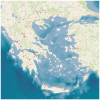Recovery of Staphylococci from Teatcups in Milking Parlours in Goat Herds in Greece: Prevalence, Identification, Biofilm Formation, Patterns of Antibiotic Susceptibility, Predictors for Isolation
- PMID: 37760724
- PMCID: PMC10525802
- DOI: 10.3390/antibiotics12091428
Recovery of Staphylococci from Teatcups in Milking Parlours in Goat Herds in Greece: Prevalence, Identification, Biofilm Formation, Patterns of Antibiotic Susceptibility, Predictors for Isolation
Abstract
The objectives of this work are (a) to describe staphylococci on the teatcups of milking parlours in goat farms and identify predictors for the presence of staphylococcal isolates on the teatcups, (b) to evaluate relationships with total bacterial counts and somatic cell counts in bulk-tank milk, and (c) to establish patterns of susceptibility to antibiotics for the staphylococcal isolates and identify predictors for the recovery of resistant isolates. In a cross-sectional study of 66 goat farms across Greece, swab samples were collected from 303 teatcups (upper and lower part) for staphylococcal recovery, identification, and assessment of biofilm formation. Details regarding health management on the farms (including conditions in the milking parlour) and the socio-demographic characteristics of farmers were collected by means of a structured questionnaire. A total of 87 contaminated teatcups (28.7%) were found on 35 goat farms (53.0%). Staphylococci were more frequently recovered from the upper than the lower part of teatcups: 73 versus 43 teatcups, respectively. After identification, 67 staphylococcal isolates (i.e., excluding similar isolates) were recovered from the teatcups; Staphylococcus aureus, Staphylococcus capitis, and Staphylococcus equorum predominated. Of these isolates, 82.1% were biofilm-forming. In multivariable analysis, the annual incidence of clinical mastitis in the herd emerged as the only significant factor associated with the isolation of staphylococci from the teatcups. Of the 67 isolates, 23 (34.3%) were resistant to at least one antibiotic, and 14 (22.4%) were multi-resistant. Resistance was found most commonly against penicillin and ampicillin (22.4% of isolates), fosfomycin (17.9%), clindamycin (14.9%), erythromycin, and tetracycline (13.4%). In multivariable analysis, the annual incidence of clinical mastitis in the herd and the use of detergent for parlour cleaning emerged as significant factors associated with the isolation of staphylococci resistant to antibiotics.
Keywords: antibiotic resistance; biofilm; goat; mastitis; methicillin; milking parlour; sheep; staphylococcus; teatcup.
Conflict of interest statement
The authors declare no conflict of interest.
Figures
Similar articles
-
Association of Staphylococcal Populations on Teatcups of Milking Parlours with Vaccination against Staphylococcal Mastitis in Sheep and Goat Farms.Pathogens. 2021 Mar 24;10(4):385. doi: 10.3390/pathogens10040385. Pathogens. 2021. PMID: 33804878 Free PMC article.
-
Irregular Findings on Teatcups in Milking Parlours in Sheep and Goat Farms and Potential Predictors.Animals (Basel). 2023 Sep 23;13(19):3004. doi: 10.3390/ani13193004. Animals (Basel). 2023. PMID: 37835610 Free PMC article.
-
Isolation of Biofilm-Forming Staphylococci from the Bulk-Tank Milk of Small Ruminant Farms in Greece.Foods. 2023 Jul 26;12(15):2836. doi: 10.3390/foods12152836. Foods. 2023. PMID: 37569105 Free PMC article.
-
Prevalence, Patterns, Association with Biofilm Formation, Effects on Milk Quality and Risk Factors for Antibiotic Resistance of Staphylococci from Bulk-Tank Milk of Goat Herds.Antibiotics (Basel). 2021 Oct 8;10(10):1225. doi: 10.3390/antibiotics10101225. Antibiotics (Basel). 2021. PMID: 34680806 Free PMC article.
-
Growth of Staphylococcus epidermidis on the Surface of Teatcups from Milking Parlours.Microorganisms. 2021 Apr 15;9(4):852. doi: 10.3390/microorganisms9040852. Microorganisms. 2021. PMID: 33921135 Free PMC article.
References
-
- Edmondson P. The milking machine and mastitis. In Pract. 1993;15:12–17. doi: 10.1136/inpract.15.1.12. - DOI
-
- Liagka D.V., Mavrogianni V.S., Cripps P.J., Michael C.K., Kalonaki S., Chatzopoulos D.C., Kantas D., Fthenakis G.C., Spyrou V., Vasileiou N.G.C. Bacterial entry into the teat of dairy ewes during the milking process. Animal Sci. Proc. 2023;14:138–139. doi: 10.1016/j.anscip.2023.01.188. - DOI
-
- Bergonier D., Berthelot X. New advances in epizootiology and control of ewe mastitis. Livest. Prod. Sci. 2003;79:1–16. doi: 10.1016/S0301-6226(02)00145-8. - DOI
-
- Clarke S.R., Foster S.J. Surface adhesins of Staphylococcus aureus. Adv. Microbial Physiol. 2006;51:187–225. - PubMed
Grants and funding
LinkOut - more resources
Full Text Sources



